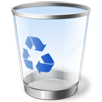Following on from the "Start" menu sections, we have added this section that deals with the options in the "Start" menu that are specific to Windows XP.
- Printers and Faxes - again this section really is self explanatory and the fax section now is almost obsolete, but if you have a printer attached to the computer you will find the installed file for it here.
- Search - this section allows you to find the files that you have stored on your computer.
- Run - this section goes back to the earlier versions of operating systems and is what is known as a Command Line, which allows you to type specific commands into the computer, most of these commands in newer versions of Windows are handled in a different way.






